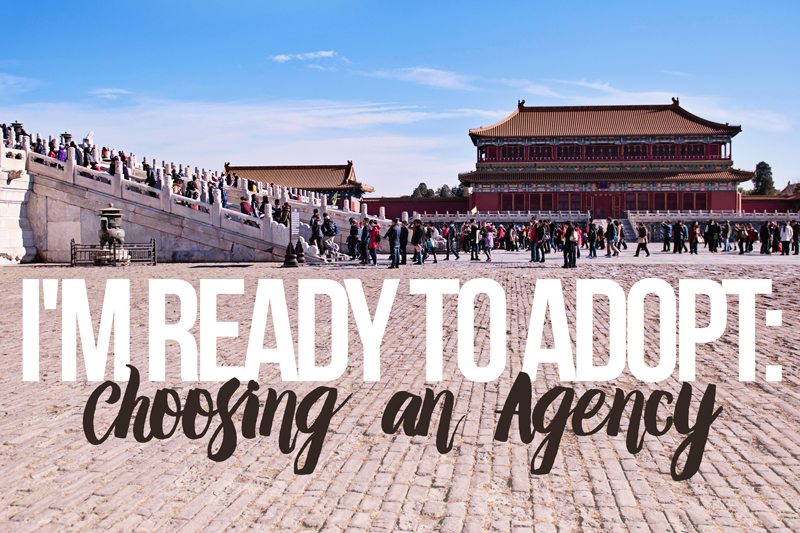Today we’re back with our I’m Ready To Adopt series with the second in a mini-series of ten posts by Kelly, who blogs at Mine In China, on How To Choose An Agency. If you haven’t already, you can read the first post here.
Things to consider when choosing your child first:
If you’ve decided that you really like the idea of finding a specific child to adopt, then you’ve probably already visited a few agency websites to view waiting child photolistings. I mentioned previously that one of the downsides to choosing your child first is that must use the agency who has the child’s file. The purpose of this post is to give you some things to consider before you start viewing an agency’s photolisting. If you find an agency you absolutely don’t want to use, then focus on the photolistings of other agencies.
Agencies know that photolistings are a good way to get new clients. Sometimes agencies will manipulate their photolistings to make their agency seem especially attractive to new clients. Here are some of the things to look for which might be a red flag signaling an unethical agency:
– Posting children they know they will place with other families. They will post a girl with minor needs and when you inquire they will say that they have another family already committed to her but they would be happy to work with you to find another child for your family.
– Selectively list a child’s needs so that she seems more minor needs than she is. Many of the children now have multiple needs so they might only mention a minor condition and omit a more serious medical condition. Be aware that profiles typically only mention a small amount of information from the file.
– Keeping old matched files up on their website to make it appear that they receive more files than they do. Remember that the amount of children you see on an agency photolisting does not in any way indicate the amount of files an agency receives.
– Look at what they promise on their website. Be wary of any agency that still characterizes adoption from China as being young girls, or states that most children have needs that are minor, correctable, or already repaired.
– The non-special needs (or “healthy” child) program with China is effectively no more. If you find an agency who is still accepting applications for this program, even though the wait is currently 8 years for a referral, I would be concerned.
– Check for the cost sheet. I will talk about cost related issues in another post but be aware that the most ethical and reputable agencies will post not only all of their charges for an adoption through their China program, but will also have a link somewhere to their total operating budget. Some agencies may choose not to post this info because they don’t want the cost of adoption to scare off potential clients, but they should make it easy to obtain a full accounting of their China program.
– Some agencies will require you to pay to view a file, or have a paid application with them to view a file. While this isn’t necessarily a red flag, be aware that most agencies will not charge at all for viewing a file so if you are in the “just looking” phase you can look at files with other agencies without any cost.
– Watch out for pressure tactics. Some agencies that fish heavily for clients through photolistings will let multiple families view a file at the same time and then place the file with the first family to decide to move forward. While this method of placing a child is not unusual, some agencies can turn it into “Hurry and act now if you want this child!” This is a big decision and if an agency is pressuring you to quickly commit then walk away. It indicates the agency is more concerned about closing the deal than finding the best placement for a child.
To check any individual agency, do a google search for “agencyname + scam or ethics.” You can also join the Rate Your Chinese Adoption Agency Facebook group and search for feedback there. Keep in mind that no agency is going to please 100% of their clients. If an agency has a waiting child that you are very interested in, don’t be scared off by a bad review or two. Just screen for persistent serious problems. There are many great agencies out there!
…..
Ways Agencies Match Children and Families:
Another important question to ask is how does an agency match photolisting children with families? You found a child you are interested in, and you want to view the file. Maybe you aren’t the only one who are interested in the child. There are three different methods that are most often used by agencies to decide which set of potential parents will end up with a child on a photolisting.
1. First Come, First Served.
The most common is First Come, First Served. The first person to ask for the file gets to review it, and other people who want to review the file are added to a list. The first couple has a certain amount of time to review the file and decide – maybe a few days, maybe a week or two. (While files which are pulled from the shared list are only locked for 72 hours, agencies have a greater latitude in their designated files.) If they decline the file then it is passed to the next family on the list, and so on until someone is ready to submit a Letter of Intent to Adopt (LOI).
Pros: Only one family views a file at a time, which does not put pressure on the family to rush into a decision. First come, first served is a principle which seems fair to Americans (further on into the process you will realize this is not an Asian view), so it is not as disappointing to not get matched with a child you love. You know it’s not personal, you just weren’t first in line.
Cons: This can really drag out the process for the other families and the child involved. If there is a child who is seriously cute but with a serious medical condition, the file could be viewed numerous times before someone is ready to write a LOI. One parent told me their child’s file was turned down 50 times before they accepted it! For children with time sensitive medical needs or who are close to aging out, this method can waste valuable time.
2. Race To The Finish
Let’s call the second method of matching Race To The Finish! Agencies who use this method will allow all interested families to view the file at the same time. The first family who is ready to write a LOI gets the child.
Pros: This more efficient method cuts down on the wasted time of First Come, First Served.
Cons: This method can really pressure families to make a decision before they’re ready. Maybe they’re still waiting to hear back from a doctor who reviewed the file but they don’t want to chance losing the child. Unethical agencies can pressure families to act quickly by saying they think another family is really interested when really, they just want to close to deal and get you to sign.
3. Committee Decides
The third method is Committee Decides. Multiple families are allowed to view a file at the same time and if multiple families are ready to move forward then an agency committee chooses from among the potential families.
Pros: Committee Decides is the least popular method and it is easy to find people who are angry about it online. From my perspective, I’m not sure how “I saw her first!” is any more fair. Committee Decides is a child-centered method to find the best family for a child. While most of the young children with minor needs would thrive in any loving family, there are often instances where some families would be a better fit than others. If a child has a time-sensitive special need such as Thalassemia, isn’t better that they be matched with a family who is already DTC so that they can come home six months sooner than if the family who saw the child first was only starting on their home study? Wouldn’t a better family for a child who is deaf be one which is already fluent in sign language and a part of the deaf community? How about older children, wouldn’t the best family for an older child be a family who is experienced with the challenges of older child adoption and who has parented past the age of the child rather than a family with only younger children and just beginning their first adoption? Agencies who use this method are committed to placements which give the child the best chance for a successful adoption.
Cons: I will also acknowledge the serious flip side to this method, which is that it is harder on the potential families. It is very common for people to feel emotionally connected to a child from the first moment they see the picture. I can understand how devastating it must be to feel deeply in your heart that this is your child, and now a committee is telling you that there is another family better for the child than yours. Not only is it a loss, but it comes as a veiled insult. If you feel you can’t handle the heartbreak of a committee deciding that you aren’t the best family for a child then it is important to know which agencies use this method and avoid their photolistings.
…..
Next week Kelly will share about LID and partnership files.
— photos by Stefanie



























Leave a Reply